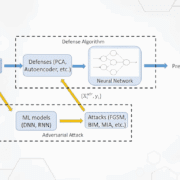The Role of GraphQL in Modern API Development
With the rising complexity of application development, the demand for flexible and efficient APIs has also increased. Traditional REST APIs are widely used as a standard to communicate backend systems and frontend applications. However, a new, more powerful API is slowly coming into the limelight: GraphQL.
In the past few years, GraphQL has gained considerable traction as a better API alternative. GraphQL can act as a game-changer in modern API development, offering enormous benefits to developers. Using GraphQL can be the next big step in offering a fresh perspective and better control to developers.
This blog post is all about the role of GraphQL in modern API development. We will delve into the basics of GraphQL, its benefits, and some of its use cases.
What is GraphQL?
GraphQL is a query language and a server-side runtime for APIs that provides the exact data that a client has requested. It was developed by Facebook in 2012 and open-sourced in 2015 intending to provide a more powerful, efficient, and flexible API option for developers and businesses.
With GraphQL, clients can use a single API call to request data from multiple data sources. This enables clients to specify the required data once and obtain highly accurate, customized responses. Clients don’t need to make multiple requests at different endpoints to fetch similar data.
How Does GraphQL Work?
At its core, GraphQL works on a simple principle– A client specifies the type and structure of the data they need, and the server responds precisely with that data only. Behind this principle, there are three main components of GraphQL: schema, resolvers, and query language.
Let’s have a look at these components in detail one by one;
Schema
The schema of GraphQL defines the types available in the API and the relation between them. The schema consists of object types that are requestable with relevant fields. Schema acts as a contract between the clients and the service providers. It specifies what data can be requested and how it is relatable to other existing data. The schema in GraphQL is written by Schema Definition Language (SDL).
Resolvers
Resolvers are the functions that are responsible for fetching data specific to each field requested in the query made by the client. Resolvers are the main characters behind collecting and resolving data from multiple data sources such as services, databases, and other APIs. Depending on the schema definition, Resolvers can fetch both scalar values (such as strings or numbers) as well as complex types (like objects or arrays).
Query Language
The “QL” in GraphQL stands for query language. The query language enables the clients to specify their data needs and requirements. The specified requirements in the form of a query are sent to the servers. Here, the query is processed by executing resolvers to fetch the required data. The server then responds as a JSON object that contains the exact data requested by the client. The graph query language can also perform other functions like queries and mutations.
Benefits of GraphQL
GraphQL was created to provide a more efficient, powerful, and flexible alternative for REST APIs. The benefits that GraphQL offers make it a better choice for most businesses in modern software development. Let’s have a look at some of it’s prominent benefits:
Single Endpoint
GraphQL has a single flexible endpoint that works as a common gateway to access the entire data graph. This eliminates the need for multiple endpoints for different versions or resources and simplifies the API design. The single endpoint also makes it easier to version and evolve the API by reducing compatibility issues, limiting the breaking of existing clients, and improving the developer’s productivity.
Flexible Responses
GraphQL does not provide clients with predefined responses, unlike other APIs. It allows them to define the structure and shape of the responses. A client can specify their requirements for each field, reducing the chances of over-fetching data and enabling efficient data transfer. This flexibility in getting specific responses enables developers to create efficient and personalized user interfaces tailored to their specific requirements.
Efficient Data Retrieval
Another prominent benefit of GraphQL is its ability to optimize data retrieval efficiently. GraphQL provides the clients with the exact data they need. This avoids over-fetching and under-fetching of data. It improves performance and minimizes network traffic, especially in the case of high-latency connections and limited bandwidths.
Best Use Case of GraphQL
Here are some of the best use cases where GraphQL can be used to get better outcomes:
Mobile Applications
Mobile applications often face the issues of limited bandwidth and variable network conditions. GraphQL can help developers optimize a mobile application for bandwidth and speed. It helps by combining multiple client requests into a single query to minimize the total number of requests made in a mobile application. This also decreases the load on the responses returned by the server. The ability of GraphQL to optimize data transfer by fetching only specific data against a request improves the responsiveness and performance of mobile applications.
Microservices Architecture
GraphQL is highly useful in applications developed with microservices architecture. In a microservices environment, each function or feature of an application is developed as independent, small services. These services interact via APIs. When the number of microservices increases in an environment, GraphQL acts as a unified API gateway. This simplifies the process of fetching data from multiple sources. GraphQL offers various benefits in microservices applications such as improved error handling, efficient request routing, and parallel request execution.
Complex Environments
GraphQL is highly useful in developing complex applications. GraphQL can help to improve efficiency and reduce the complexity of applications that interact with legacy systems, large databases, and third-party APIs. It helps you to get specific data from multiple sources without the need to define where the resources reside. GraphQL adds an abstraction layer that hides the complexity of the underlying system. The real-time data fetching of GraphQL also contributes to decreasing complexity in applications that need live data feeds.
Conclusion
The introduction of GraphQL was a significant step towards efficient software development. It successfully serves its motive to deliver efficient, flexible, and adaptable API solution that aligns with the needs of modern developers and businesses. GraphQL is a better choice for developers due to its minimal complexities and better efficiency.
Although graphQL is still new, its adaptation has started to grow. Widespread support from open-source communities and major tech companies clearly indicates that its role is important in shaping modern API development. Whether you’re building a simple application or a complex microservices architecture, GraphQL can provide compelling API solutions. Give it a try now!




